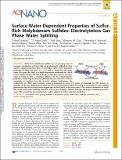Surface Water Dependent Properties of Sulfur-Rich Molybdenum Sulfides: Electrolyteless Gas Phase Water Splitting
Author(s)
Daeneke, Torben; Dahr, Nripen; Atkin, Paul; Clark, Rhiannon M; Harrison, Christopher J; Brkljača, Robert; Pillai, Naresh; Zhang, Bao Yue; Zavabeti, Ali; Ippolito, Samuel J; Berean, Kyle J; Ou, Jian Zhen; Strano, Michael S; Kalantar-zadeh, Kourosh; ... Show more Show less
DownloadPublished version (4.501Mb)
Terms of use
Metadata
Show full item recordAbstract
© 2017 American Chemical Society. Sulfur-rich molybdenum sulfides are an emerging class of inorganic coordination polymers that are predominantly utilized for their superior catalytic properties. Here we investigate surface water dependent properties of sulfur-rich MoSx (x = 32/3) and its interaction with water vapor. We report that MoSx is a highly hygroscopic semiconductor, which can reversibly bind up to 0.9 H2O molecule per Mo. The presence of surface water is found to have a profound influence on the semiconductor's properties, modulating the material's photoluminescence by over 1 order of magnitude, in transition from dry to moist ambient. Furthermore, the conductivity of a MoSx-based moisture sensor is modulated in excess of 2 orders of magnitude for 30% increase in humidity. As the core application, we utilize the discovered properties of MoSx to develop an electrolyteless water splitting photocatalyst that relies entirely on the hygroscopic nature of MoSx as the water source. The catalyst is formulated as an ink that can be coated onto insulating substrates, such as glass, leading to efficient hydrogen and oxygen evolution from water vapor. The concept has the potential to be widely adopted for future solar fuel production.
Date issued
2017Department
Massachusetts Institute of Technology. Department of Chemical EngineeringJournal
ACS Nano
Publisher
American Chemical Society (ACS)